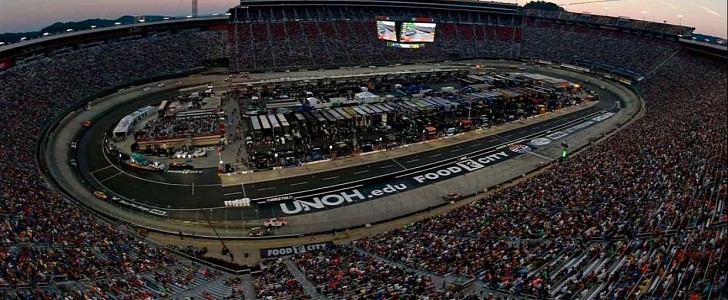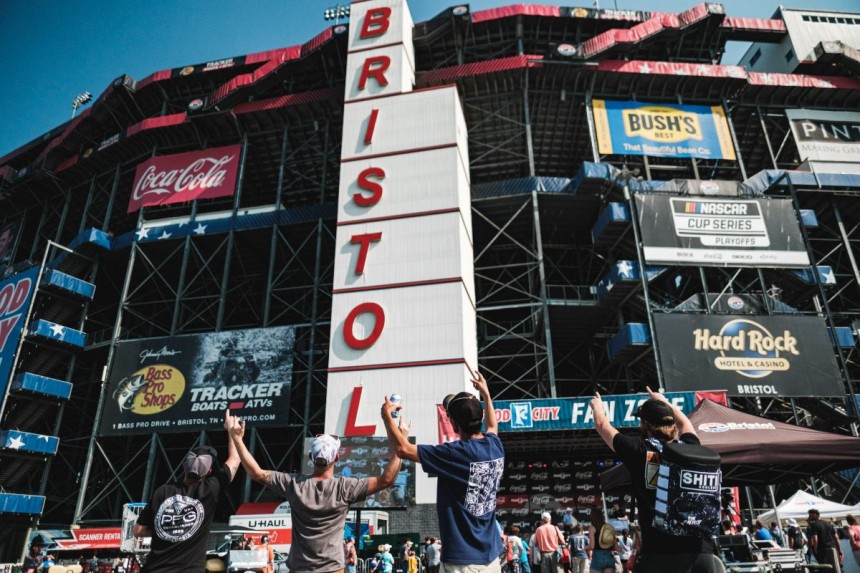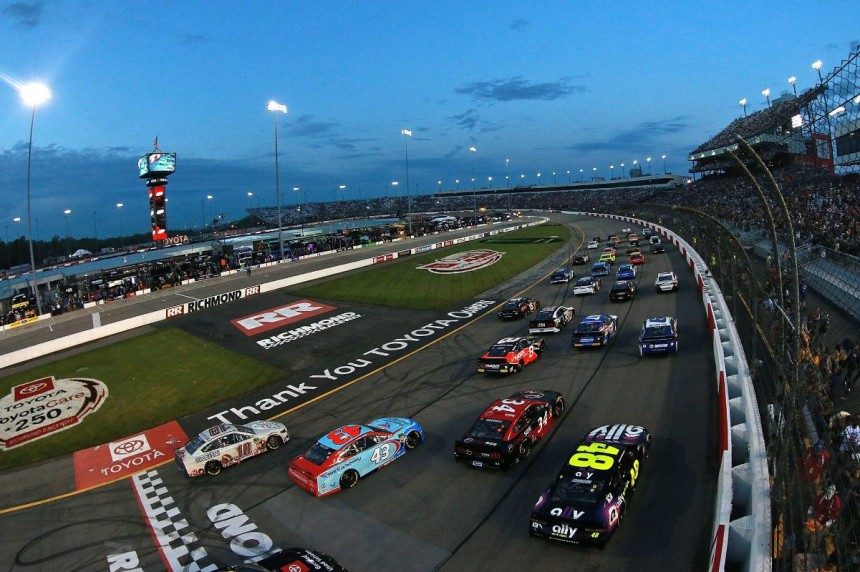It's no secret that NASCAR's popularity has fallen significantly since its highest point in the mid-2000s. And one of the primary reasons for that it's the low number of short tracks that are used. After all, they are the reason for the most exciting races in recent times.
Ideas on rectifying this problem span the gamut between the sensible and the absurd, making it more about entertainment than actual races. NASCAR has tried everything from holding street races in the middle of major and important cities to trying all types of underwhelming events to attract more fans. However, if you ask fans about what should be done, one suggestion that always comes up, no matter what color, age or race, creed, or any other category fans fall into, is that we need more short tracks. It's basically the one thing NASCAR fans can all agree on. Plus, this type of circuit really makes sense.
A short track is technically any oval track that is less than a mile in length. As a result, startup costs are relatively low. A smaller space needed means that less money is required to pay for upkeep and property taxes. Plus, short tracks almost always put on a good show from a racing standpoint. But why is that, you might ask? Well, for one very simple reason.
Think about it, less space means more contact, and NASCAR has always been one of the few motorsports where intentional and unintentional contact is not just tolerated but actually encouraged. And the close quarters mean that no driver can get too far away from anyone else, so there is always something going on.
But the main problem is that attendance is down at these tracks. The NASCAR Cup Series currently only runs at three sort tracks, which are pretty downsized, and some look like they are abandoned, to be honest. In addition, another big problem is represented by the fact that all three short tracks compete for the same group of people in the Tennessee/Virginia area. When you have other significant events in the same place, of course no one will show up. To show up at three, four, or even more different events is challenging because NASCAR is pretty expensive, even if you're local and don't have to camp out or get a hotel. Making matters worse is that those three circuits hold their races back to back to back three weeks in a row for the spring races.
While NASCAR was building a lot of new tracks in different areas of America, they saw the opportunity of having six-figure numbers of people show up at big circuits. As a result, big and long was the way to go. Besides, officials were pushing to make this competition more civilized around that time. Teams and sponsors didn't want beating and banging hot-heated guys out there. Instead, they opted for talented athletes making clean passes with skill rather than muscle.
Racing at these new tracks was mediocre at best most of the time. Cars were getting too far apart for any action to occur, and as cars became more aerodynamically dependent thanks to new technological advances, it only worsened the problem. During this time, no short tracks were built as they were seen as relics from the past, and everyone wanted the new super speedways that were some of the largest sporting venues ever made in history. As a "fun" fact, the last time a brand new short circuit was added to the official schedule was all the way back in 1970 when the Albany-Saratoga Speedway hosted two races.
Since then, we have been chipping away at these types of circuits. From 1972 to 1984, there were five short tracks on the schedule. In a funny way, the other two additional places are right next to the other three we were talking about earlier. Furthermore, the only two possible candidates for new short tracks being added to the competition's schedule are Nashville and North Wilkesboro, which have just been greenlighted for big renovations.
The prices going up didn't make things any better. If you think about it, NASCAR has always relied on a thriving middle class to show up to races. For most people, the cost of going to two or three races a year was doable. But that was back in the 90s. Nowadays, a ticket's price is too much for ordinary people, and it's just not worth it. However, these things are more about politics and the disappearing of specific jobs for the middle class and so on. We won't get into that, but it's a fact that attendance is down in every major sport in the United States because the prices are too high.
In addition, when NASCAR built all those new tracks in big markets back in the 1990s, it was because they saw the writing on the wall. People were moving to big and important cities, where they could profit from certain opportunities. NASCAR wagered that those people would keep coming to races, but as we see now, they were wrong. The competition just doesn't appeal to the metropolitan because its heart and soul are in the small towns. For example, almost all the drivers from the previous generation came from very humble beginnings, representing ordinary people doing some very unordinary things.
This season, NASCAR held the Busch Clash at a temporary short track constructed inside LA Coliseum. The race received some excellent reviews and looks to host the event again in 2023. Maybe stadium races are the answer for the future.
With the geographical and economic problems that short tracks in the NASCAR Series Cup are facing, it's tough to find a solution, and these types of circuits might go extinct in the near future.
A short track is technically any oval track that is less than a mile in length. As a result, startup costs are relatively low. A smaller space needed means that less money is required to pay for upkeep and property taxes. Plus, short tracks almost always put on a good show from a racing standpoint. But why is that, you might ask? Well, for one very simple reason.
Think about it, less space means more contact, and NASCAR has always been one of the few motorsports where intentional and unintentional contact is not just tolerated but actually encouraged. And the close quarters mean that no driver can get too far away from anyone else, so there is always something going on.
But the main problem is that attendance is down at these tracks. The NASCAR Cup Series currently only runs at three sort tracks, which are pretty downsized, and some look like they are abandoned, to be honest. In addition, another big problem is represented by the fact that all three short tracks compete for the same group of people in the Tennessee/Virginia area. When you have other significant events in the same place, of course no one will show up. To show up at three, four, or even more different events is challenging because NASCAR is pretty expensive, even if you're local and don't have to camp out or get a hotel. Making matters worse is that those three circuits hold their races back to back to back three weeks in a row for the spring races.
Racing at these new tracks was mediocre at best most of the time. Cars were getting too far apart for any action to occur, and as cars became more aerodynamically dependent thanks to new technological advances, it only worsened the problem. During this time, no short tracks were built as they were seen as relics from the past, and everyone wanted the new super speedways that were some of the largest sporting venues ever made in history. As a "fun" fact, the last time a brand new short circuit was added to the official schedule was all the way back in 1970 when the Albany-Saratoga Speedway hosted two races.
Since then, we have been chipping away at these types of circuits. From 1972 to 1984, there were five short tracks on the schedule. In a funny way, the other two additional places are right next to the other three we were talking about earlier. Furthermore, the only two possible candidates for new short tracks being added to the competition's schedule are Nashville and North Wilkesboro, which have just been greenlighted for big renovations.
The prices going up didn't make things any better. If you think about it, NASCAR has always relied on a thriving middle class to show up to races. For most people, the cost of going to two or three races a year was doable. But that was back in the 90s. Nowadays, a ticket's price is too much for ordinary people, and it's just not worth it. However, these things are more about politics and the disappearing of specific jobs for the middle class and so on. We won't get into that, but it's a fact that attendance is down in every major sport in the United States because the prices are too high.
This season, NASCAR held the Busch Clash at a temporary short track constructed inside LA Coliseum. The race received some excellent reviews and looks to host the event again in 2023. Maybe stadium races are the answer for the future.
With the geographical and economic problems that short tracks in the NASCAR Series Cup are facing, it's tough to find a solution, and these types of circuits might go extinct in the near future.














